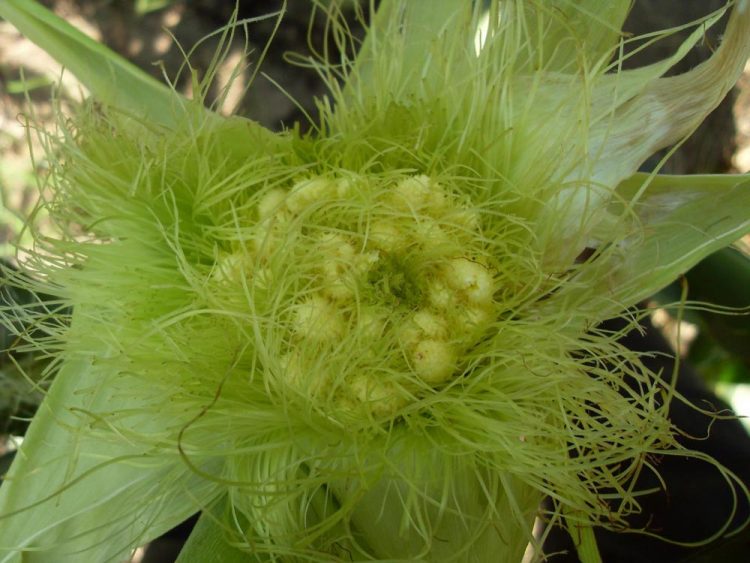Unique communication strategy discovered in stem cell pathway controlling plant growth

Pathways that control plant stem cells can be modified to make plants generate bigger fruits or more seeds. The tip of this ear of corn is growing abnormally, but provided scientists with information about how to tweak expression of a key gene to boost yield. Credit: Jackson Lab, CSHL
This is the first such multi-functional receptor found to work in this way to control plant development. The new findings obtained by CSHL Professor David Jackson and colleagues may have important implications for efforts to boost yields of essential food crops such as corn and rice.
Plant growth and development depend on structures called meristems – reservoirs in plants that contain stem cells. When prompted by peptide signals, stem cells in the meristem develop into any of the plant's organs – roots, leaves, or flowers, for example.
These signals generally work like a key (the peptide) fitting into a lock on the surface of a cell (the protein receptor). The lock opens momentarily, triggering the release of a chemical messenger inside the cell. The messenger carries instructions for the cell to do something, such as grow into a root or flower cell or even stop growing altogether. Conventionally, one or more peptides fit into a receptor to release a single type of chemical messenger.
Jackson and colleagues, however, recently discovered that a protein receptor they first identified in 2001, called FEA2, can can trigger the release of one of two distinct chemical messengers, CT2 or ZmCRN, depending on which of two peptides, ZmCLE7 or ZmFCP1, switches it on. Receptors that release more than one messenger are rare. Jackson says this is the first one discovered that plays a role in crop production.
FEA2 is an important receptor in the CLAVATA signaling pathway, which is known to activate stem cells. Jackson, as well as his CSHL colleague Professor Zachary Lippmann, have previously tweaked this pathway to manipulate the meristem to boost the yield of prominent crop species including tomato, corn, and mustard.
Jackson and his team believe that FEA2 is bound to two different co-receptors, each of which acts as the “lock” for one of the two peptide “keys.” Future research will explore how the two different peptide signals are translated by FEA2 into distinct chemical messages.
“We think the way this stem cell signaling pathway works is fundamental to all plants,” Jackson says. “We have shown that, in theory, the pathways that control stem cells can be modified to make bigger fruits or more seeds. With this study we've learned something new about how these pathways work, giving plant scientists another tool for improving crop yields.”
###
Funding
National Institute of Food and Agriculture, National Science Foundation, Next-Generation BioGreen 21 Program, Human Frontier Science Program
Citation
Je, B.I., et al., “The CLAVATA receptor FASCIATED EAR2 responds to distinct CLE peptides by signaling through two downstream effectors” appeared online in eLife March 15, 2018.
About Cold Spring Harbor Laboratory
Founded in 1890, Cold Spring Harbor Laboratory has shaped contemporary biomedical research and education with programs in cancer, neuroscience, plant biology and quantitative biology. Home to eight Nobel Prize winners, the private, not-for-profit Laboratory employs 1,100 people including 600 scientists, students and technicians. The Meetings & Courses Program annually hosts more than 12,000 scientists. The Laboratory's education arm also includes an academic publishing house, a graduate school and the DNA Learning Center with programs for middle and high school students and teachers. For more information, visit http://www.
Media Contact
All latest news from the category: Agricultural and Forestry Science
Newest articles

First-of-its-kind study uses remote sensing to monitor plastic debris in rivers and lakes
Remote sensing creates a cost-effective solution to monitoring plastic pollution. A first-of-its-kind study from researchers at the University of Minnesota Twin Cities shows how remote sensing can help monitor and…

Laser-based artificial neuron mimics nerve cell functions at lightning speed
With a processing speed a billion times faster than nature, chip-based laser neuron could help advance AI tasks such as pattern recognition and sequence prediction. Researchers have developed a laser-based…

Optimising the processing of plastic waste
Just one look in the yellow bin reveals a colourful jumble of different types of plastic. However, the purer and more uniform plastic waste is, the easier it is to…



